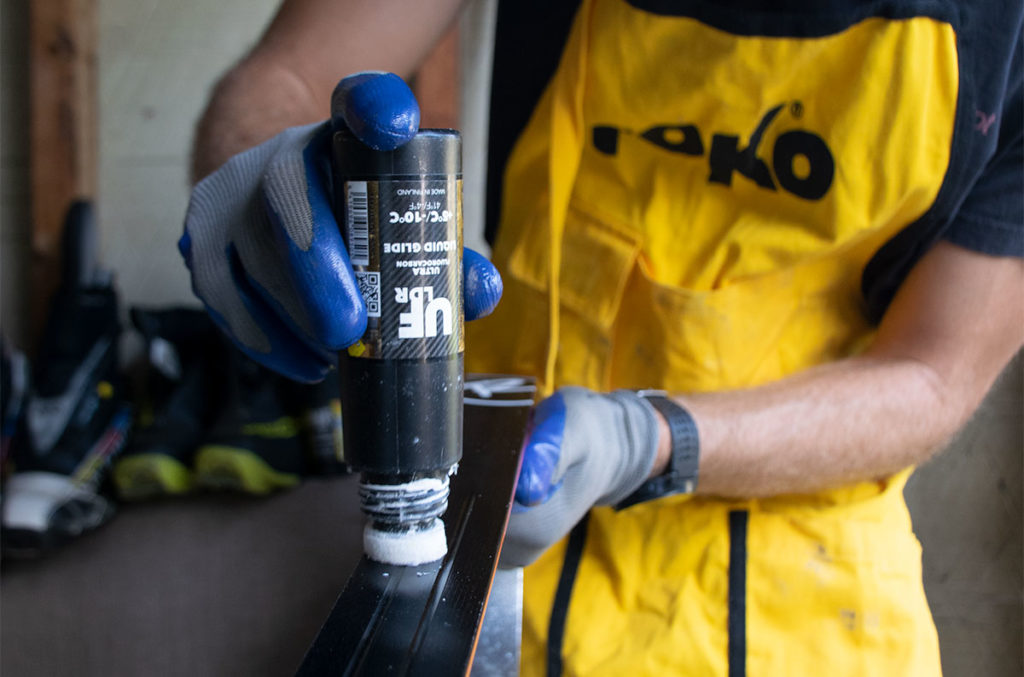
Back Shop is supported by Craft—designing Nordic ski collections worthy of World Champions and Everyday Heroes. craftsports.us
A dimly lit basement workbench. The sharp scratches of wax being scraped from a ski base. Rhythmic swipes of a brush. A thin wisp of smoke coiling up from a hot iron. This is an idyllic ski scene; the dedicated skier burning the midnight fluoro, preparing diligently for the next morning’s outing.

But big changes in the glide-waxing world might make this scene a little less common. You’re likely to see some skiers now swapping their bricks and chunks of wax for sponge applicators, aerosol sprays and a ski that’s waxed in a matter of seconds. Where did this all come from? And more importantly, is it any good?
Liquid waxes have been around for some time in the world of klister. Much like the newer liquid glide waxes, these were applied either via a continuous aerosol spray or a foam head. “Spray klisters” as they became colloquially known, were often praised in the recreational world for their ease of use, but derided by racers for their lack of durability and inability to layer and mix in various mad-scientist combinations.
Many skiers are also familiar with liquid fluorocarbon waxes, the high-end race weapons that can cost hundreds of dollars for an eye-dropper worth of speed. Spill or spray a bit in the wrong direction, and you may as well be rubbing your paycheck onto your ski base.
Glide waxes, on the other hand, are relatively straightforward. Are they getting into the ski? Well then, you’re all set. Whether it’s a spray can or a rub-on applicator, liquid glide waxes work by suspending paraffin material in a transporting liquid. The base of a ski is like a sponge at the microscopic level, and as the liquid component dries and evaporates, it leaves the wax inside the porous material.
By altering the fluorocarbon content of each bottle, wax companies can easily match and label liquid waxes to correspond precisely to their traditional paraffin counterparts. Your favorite brand’s version of a mid-range solid low-fluro wax, for example, will likely be labelled the exact same way in liquid form and will perform in the same set of conditions. Most companies already complete a match of their traditional lineup with non-fluoro (with monikers such as “NF” or “CH”), low fluoro (“LF”), and high fluoro (“HF”) options.
The process to apply is simple. Begin with a clean, scraped and brushed ski base. Apply the liquid paraffin in an even layer and let it dry—15 to 20 minutes seems to be a general rule. A dry, warm room creates the best conditions for this process. If you are headed out to ski after work, just wax up in the morning. There’s also nothing wrong with applying liquid paraffin before heading out, cranking up the heat in your car and having your skis ride shotgun for the trip to the trailhead. If you’re relegated to colder outdoor waxing with liquids, leave a little extra time. Once dry, the skis can either be brushed lightly with a nylon wax brush or simply “skied-in” for a couple hundred meters.
Utilizing liquid paraffins can bring a huge change in standards for individuals or teams. There is almost no learning curve, no iron fumes or smoking heat sources and no cleanup, and the time savings alone make a startling difference in wax-room efficiency.
You can’t totally ditch the iron, though: your skis still need the thirst-quenching effect of traditional, ironed-in paraffin from time to time. Wax guru Zach Caldwell of Caldwell Sport suggests re-applying a traditional paraffin every 100-150km for recreational skiers. Racers will want to be sure to use a glide wax cleaner after competition and then apply a traditional “travel wax” layer to the bases. For racers or teams looking to focus on liquid paraffins, a reliable method involves selecting a non-fluoro of low-fluoro base layer that’s relatively cold and hard as a first step for any condition, and then applying the liquid paraffin of the day once that first layer has been scraped and brushed.
Key Tips for Liquid Paraffin
Drying is Crucial. Be sure to let your skis dry completely once the paraffin has been applied. Bonus old-school method? If you have a woodstove, place your skis near it to really nail the process.
Race Day Application. Because of their speed to apply, in a race situation you can wait until you arrive at the venue to check snow conditions or even test HF liquid paraffins on race morning to dial-in the best glide for the day.
Never Forget to Clean. It’s easy to keep putting liquid wax into your skis, but things can get clogged up quickly. It’s absolutely crucial to regularly clean your bases with a dedicated glide wax or fluoro cleaner.
More is Not Better. Apply liquid paraffin in an even layer, but don’t overdo it. One bottle can last a surprisingly long time and be extremely cost effective.
—
Adam Terko is the head coach of Vermont’s Mansfield Nordic Club and has been skiing competitively (and writing about it) since before Fischer skis had holes in their tips. He’s also the technical editor of Cross Country Skier and writes the how-to column “Back Shop” in each issue.
Subscribe now to the print magazine to read Terko’s latest column and more at crosscountryskier.com/subscribe.